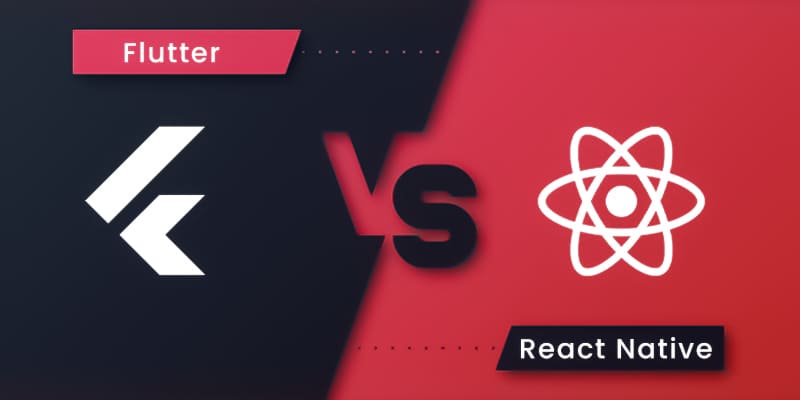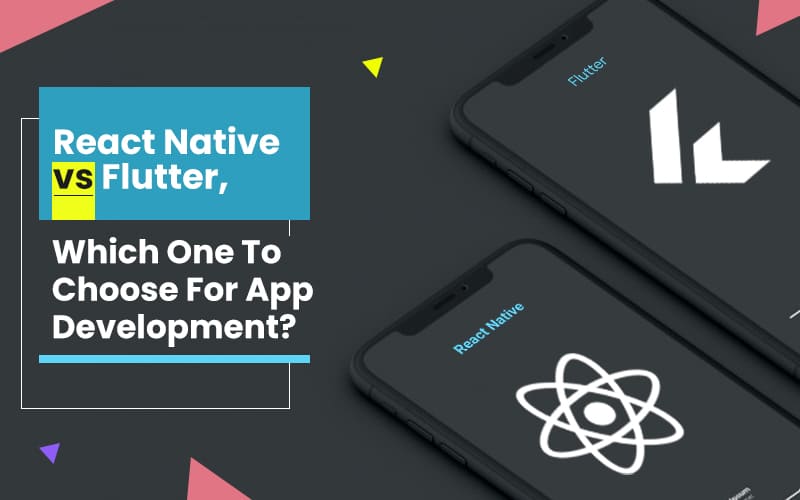React Native vs Flutter: Which One To Choose For App Development?
When it comes to building an app for your business, there’s always the question of which platform to use to get the maximum customer involvement. To remain competitive in the industry and keep up with the current trends, many businesses are developing mobile applications. We’ve spoken about the differences between Flutter and React Native app development to clear things up for you.
The discussion between Flutter vs React Native continues, as both technologies have some of the best choices for mobile app development, web development, and cross-platform app development. You won’t believe global mobile app profits will rise by more than 365 billion dollars in 2023, as per Statista. Massive, isn’t it?
As the total number of users on the Apple Store and Play Store Market continues to rise at a breakneck pace, more and more companies are striving for a piece of the action by introducing the next game-changing service. Do you have an excellent idea for a mobile app for your company? But you’re stumped as to which technology to use?
In this blog post, we’ll compare two prevalent development technologies. Keep reading to learn what you need to know about two of the most popular technologies available in the market: Flutter app development and React Native; also, you’ll be able to say which is the best option for your business plan? By the end of this blog!
But firstly,
What is Flutter?
Flutter is a user interface software development framework built on the Dart object-oriented programming language. The system comes with two sets of entirely customizable widgets that take into account all important platform variations, so there’s no need to search for additional resources to create a nice-looking GUI.
Flutter is also an improved UI toolkit that allows developers to build cross-platform apps using a single codebase. It allows Flutter developers to create a versatile and expressive user interface with native efficiency. Besides that, a team of Google engineers and the entire flutter community have contributed and sponsored it.
Moving on,
What are the Advantages & Disadvantages of Flutter App Development?
Advantages of flutter app development
- Single codebase
- Easy pixel rendering
- It includes a collection of widgets that you can personalize or even build yourself
- Quick app development
- Flutter apps are quick and responsive, never lagging when scrolling
- Easy access to native functionality
- The hot reloading functionality, which displays changes in the output without changing the application’s state, is a significant component
- Flutter app development allows for a quicker Quality Assurance
As we discussed the advantages of flutter for app development, now let’s move forward and discuss some cons of flutter.
Recommended Read– Top Reasons to Choose Flutter for App Development in 2021
Few Disadvantages of Flutter
- It is still an emerging technology with a small developer group
- While Flutter is simple to learn, you’ll likely need to have some native app development expertise to create a successful cross-platform app
- Flutter has a large number of libraries and support options. It is, nevertheless, not as important as it is in React Native or native development innovations
- Flutter-based applications are more prominent than native apps
What apps are developed using flutter?
Despite the fact that Flutter is a comparatively recent framework, Flutter for app development has been used to build several groundbreaking smartphone applications. Many of them made significant changes in marketing, banking, e-commerce, and other fields. So, let’s have a look at a couple of them:
- Google Ads
- Alibaba
- Birch Finance
- Reflect
- JD finance app
- Tencent
- BMW
- Philips Hue
Moving on, let’s quickly discuss!
What is React Native?
React Native is a cross-platform framework for developing native apps that Facebook released in 2015. It is built on the React platform, which is based on JavaScript. React Native is helpful in creating mobile apps that use JavaScript and have the same architecture as react applications. JavaScript is employed by React Native. It works with the bridge principle, which allows native and JS threads to communicate.
Moving on,
What are the Advantages & Disadvantages of React Native App Development?
Advantages of react native app development
- Reduces development cycles
- React Native has a feature called hot reload. This speeds up development by allowing developers to attach new code to an already running app. They are able to see all of the changes in real-time
- Easy to learn
- React Native allows developers a lot of flexibility when it comes to choosing which approaches to use. They may use JavaScript or Typescript, as well as a customized UI library or create their own
- Smart debugging and error detection tools are available to you
- Uses the host system to render APIs natively without the need for HTML or CSS scripting
Few Disadvantages of React Native
- React for app development isn’t the right alternative, especially for games or applications with a lot of animation
- Some unique, platform-specific components are still missing, and you’ll need the help of a native developer to build them
- Since they lack built-in plugins and software, you’ll have to depend on third-party tools, which are often obsolete
- You can find it problematic to review codes or modify UI elements if you don’t have a chrome debugger
- Some native UI components may not be supported by native API rendering, causing the UI to appear skewed
What apps are developed using React Native?
Apart from Facebook’s products, there are a number of other well-known companies on the catalog of React Native App Development like:
- Walmart
- Uber
- Tesla
- Bloomberg
- Towns
- Airbnb
- SoundCloud
- Skype
We just took a close look at both technologies. Let us now compare these technologies based on a variety of factors. So let’s dive in!

React Native vs Flutter: In-depth Comparison
From a business standpoint, we described essential elements to consider when selecting an app development framework. So take a look!
1. Development Time
The plethora of mobile app development company that have sprung up in recent years have proven their ability to produce projects on schedule. React Native has remained one of the most vital collaborators for all of them. This system shortens the time it takes to create a mobile app, improves the user experience, and speeds up project creation.
When comparing React Native and Flutter, it’s worth noting that Flutter is recent and takes a long time to develop projects, particularly if we’re talking about this platform in this context. React Native comes with ready-to-use components that help developers speed up creating mobile apps without causing too many issues.
2. Scalability
Flutter is simple to use and implement, allowing for greater versatility and scalability. With each update, Flutter developers note small upgrades in the personalized widgets and features. It enables developers to build applications that are highly scalable. Besides, for critical native interfaces like NFC payment, biometric data, and Wi-Fi, React Native has extensive API support. Geolocation, Wireless, and Wi-Fi interfaces of devices using applications are also supported.
3. UI Components
To interact with UIs that must be made, React Native uses JavaScript connectors. Additionally, Objective-C APIs and Java APIs are required for mapping on IOS and Android, accordingly. In comparison to React Native, Flutter does not depend on the platform’s APIs. It has a library of components that developers can use to create interactive UIs, and all of the required plugins are contained in a single toolkit. Another advantage of Flutter is that it has a canvas function that builds user interfaces that are nearly identical across all mobile platforms.
4. Code Capability
Flutter eliminates the need for design, style, and data segregation. Instead, it allows developers to code anything from a single location and gives them access to all of the necessary resources. Even so, code sharing for Flutter-based apps is currently restricted to Android and IOS only. Besides, React Native’s code structure is more complicated than Flutter’s. However, third-party libraries exist that allow you to exchange code between Android, IOS, and Windows OS and between web applications.
5. Community Support
From assistance for integrated development environments (IDEs) to community support, it’s essential to consider whether the cross-platform app framework you select has everything you need. React Native is perhaps the most general framework on Stack Overflow and is accompanied by a large community. It was released as open-source on GitHub in 2015. It has a significant following and has remained relatively stable since its inception. Flutter is a relatively new platform, but it has grown in popularity in recent years, with a significant rise in community participation.
6. Architecture
Both approaches are very close at their source. They design the user interface in a declarative manner and are very versatile, allowing the developer to use various methods to handle the application’s structure. Plugins are used to gain access to computer features.
The Flutter architecture has a layered architecture that allows for complete configuration as well as fast rendering. The C++ engine runs perfectly, and the majority of the components and critical functionality are built-in. Besides, React Native has a one-way data flow, and the application’s state can indeed be saved in a central location called Store, allowing the application’s elements to be as stateless as feasible.
So, as we have done with the comparison, now let’s move forward and discuss when and for what you can do with flutter app development or react native app development.
When to choose Flutter App Development?
You can choose flutter for app development when:
Flutter is a valuable platform for small companies and entrepreneurs. It’s ideal if you need an inexpensive app development tool that allows you to see a live preview of improvements made to the app, so use it if you need to create an MVP quickly.
Some other key points!
- It would be best if you used widgets to personalize the UI and evaluate less
- You can use flutter for flexible UI and elevated widgets
- You’re concentrating on developing high-performing applications
When to choose React Native App Development?
You can choose to react native app development when:
- For large and complex projects
- For applications with reusable components
- For developing lightweight apps
- When you want to make an asynchronous system with a fast-responding user interface
Conclusion
In terms of complexity, support groups, and other factors, Flutter and React Native App Development each have their own set of advantages and disadvantages. It is entirely up to you and your developer to choose which framework you want to use. Flutter is a Google UI toolkit; it contains all of the necessary development tools in one spot. However, we can’t even say the exact for React Native. The majority of third-party libraries can be found on external resources. Finding the appropriate materials for your app can take a long time at times. React Native, on the other hand, has a greater audience than Flutter.
Without being biased, this blog compares React Native and Flutter in-depth. So, if you’re looking for a trustable React Native and Flutter app development company, reach out to Matellio! And our tech experts will happily assist you in determining the best way to scale your business or company.
Thanks for reading!






